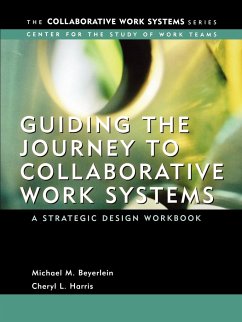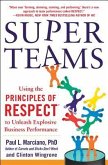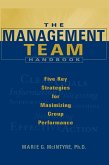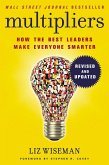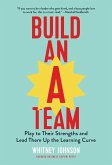Michael M. Beyerlein, Cheryl Harris
Guiding the Journey to Collaborative Work Systems
A Strategic Design Workbook
Michael M. Beyerlein, Cheryl Harris
Guiding the Journey to Collaborative Work Systems
A Strategic Design Workbook
- Broschiertes Buch
- Merkliste
- Auf die Merkliste
- Bewerten Bewerten
- Teilen
- Produkt teilen
- Produkterinnerung
- Produkterinnerung
Guiding the Journey to Collaborative Work Systems is a hands-on, practical guide for dealing with the challenges of designing and implementing collaboration in the workplace. People working in groups and teams, team-based organizations and networked organizations, and value chains and strategic alliances understand that effective collaboration is mandatory for success in today's business environment. Change leaders3/4such as organization development managers, steering committee members, design team members, line managers, and others-- will find this workbook an invaluable source of help, as it…mehr
Andere Kunden interessierten sich auch für
![Mining Group Gold, Third Edition: How to Cash in on the Collaborative Brain Power of a Team for Innovation and Results Mining Group Gold, Third Edition: How to Cash in on the Collaborative Brain Power of a Team for Innovation and Results]() Thomas A. KayserMining Group Gold, Third Edition: How to Cash in on the Collaborative Brain Power of a Team for Innovation and Results41,99 €
Thomas A. KayserMining Group Gold, Third Edition: How to Cash in on the Collaborative Brain Power of a Team for Innovation and Results41,99 €![The Facilitator's Fieldbook The Facilitator's Fieldbook]() Tom JusticeThe Facilitator's Fieldbook55,99 €
Tom JusticeThe Facilitator's Fieldbook55,99 €![Superteams: Using the Principles of Respect(tm) to Unleash Explosive Business Performance Superteams: Using the Principles of Respect(tm) to Unleash Explosive Business Performance]() Paul L. MarcianoSuperteams: Using the Principles of Respect(tm) to Unleash Explosive Business Performance33,99 €
Paul L. MarcianoSuperteams: Using the Principles of Respect(tm) to Unleash Explosive Business Performance33,99 €![The Management Team Handbook The Management Team Handbook]() Marie G. McIntyreThe Management Team Handbook54,99 €
Marie G. McIntyreThe Management Team Handbook54,99 €![The Collaborative Work Systems Fieldbook The Collaborative Work Systems Fieldbook]() The Collaborative Work Systems Fieldbook66,99 €
The Collaborative Work Systems Fieldbook66,99 €![Multipliers Multipliers]() Liz WisemanMultipliers13,99 €
Liz WisemanMultipliers13,99 €![Build an A-Team: Play to Their Strengths and Lead Them Up the Learning Curve Build an A-Team: Play to Their Strengths and Lead Them Up the Learning Curve]() Whitney JohnsonBuild an A-Team: Play to Their Strengths and Lead Them Up the Learning Curve25,99 €
Whitney JohnsonBuild an A-Team: Play to Their Strengths and Lead Them Up the Learning Curve25,99 €-
-
-
Guiding the Journey to Collaborative Work Systems is a hands-on, practical guide for dealing with the challenges of designing and implementing collaboration in the workplace. People working in groups and teams, team-based organizations and networked organizations, and value chains and strategic alliances understand that effective collaboration is mandatory for success in today's business environment. Change leaders3/4such as organization development managers, steering committee members, design team members, line managers, and others-- will find this workbook an invaluable source of help, as it provides a step-by-step planning process to transform an organization to better support collaboration. Teams and groups can use the workbook to improve their collaborative processes, and elements of the workbook can be applied to a wide variety of situations where collaboration is needed. The workbook covers a broad range of topics necessary for successful change, including generating and maintaining support for the initiative, launching a thoroughly planned change program, and effectively communicating the plan to the rest of the organization. Filled with assessments, tools, and activities, and based on interviews conducted with twenty-one experts and hundreds of team members, Guiding the Journey to Collaborative Work Systems offers the support needed to design in-depth plans for changing work systems to facilitate collaborative excellence.
Hinweis: Dieser Artikel kann nur an eine deutsche Lieferadresse ausgeliefert werden.
Hinweis: Dieser Artikel kann nur an eine deutsche Lieferadresse ausgeliefert werden.
Produktdetails
- Produktdetails
- Collaborative Work Systems Series
- Verlag: Wiley & Sons
- Seitenzahl: 404
- Erscheinungstermin: 22. September 2003
- Englisch
- Abmessung: 280mm x 210mm x 23mm
- Gewicht: 980g
- ISBN-13: 9780787967888
- ISBN-10: 0787967882
- Artikelnr.: 12336194
- Herstellerkennzeichnung
- Libri GmbH
- Europaallee 1
- 36244 Bad Hersfeld
- gpsr@libri.de
- Collaborative Work Systems Series
- Verlag: Wiley & Sons
- Seitenzahl: 404
- Erscheinungstermin: 22. September 2003
- Englisch
- Abmessung: 280mm x 210mm x 23mm
- Gewicht: 980g
- ISBN-13: 9780787967888
- ISBN-10: 0787967882
- Artikelnr.: 12336194
- Herstellerkennzeichnung
- Libri GmbH
- Europaallee 1
- 36244 Bad Hersfeld
- gpsr@libri.de
Michael M. Beyerlein is director of the Center for the Study of Work Teams and professor of industrial/organizational psychology at the University of North Texas. He is author or editor of numerous articles and books, including Beyond Teams and The Collaborative Work Systems Fieldbook (both from Pfeiffer). Cheryl L. Harris is a consultant and researcher, affiliated with the Center for the Study of Work Teams. She facilitates organizations in their change efforts to better support collaboration, is author of several book chapters, and has developed a Web-based assessment tool for collaborative work systems.
List of Figures, Tables, and Tools.
Preface for the Collaborative Work Systems Series.
Acknowledgments.
Preface.
INTRODUCTION UNDERSTAND THE STRATEGIC DESIGN PROCESS.
Chapter 1: How to Use This Workbook.
Rationale for the Workbook.
Goals of the Workbook.
Workbook Organization.
Elements in Each Chapter.
Practical Focus.
Approaches to the Material.
Content Icons.
Special Terms.
The Collaborative Work Systems Series.
Conclusion.
Resources.
Chapter 2: Learn the Basics of Collaborative Work Systems.
Key Question of This Chapter.
Quick Look.
What Is a Collaborative Work System?
Types of Collaborative Work Systems.
Understand the Current Organization.
Select the Collaborative Work System Target.
Conclusion.
Keys to the Chapter.
Chapter Wrap-Up.
Resources.
Chapter 3: Start with the Guiding Assessment.
Key Question of This Chapter.
Quick Look.
The Strategic Design Process and Guiding Assessment.
Part I: Create a Foundation for Change.
Part II: Align the Organization for Collaboration.
Summarize the Pressures For and Against Change.
Conclusion.
Keys to the Chapter.
Chapter Wrap-Up.
Resources.
PART I: CREATE A FOUNDATION FOR CHANGE.
Chapter 4: Launch the Change Leadership Team.
Key Question of This Chapter.
Quick Look.
Launch the Change Leadership Team.
Select CLT Members.
Build Common Understanding.
Manage Team Boundaries.
Invest in Team Competencies.
Manage the Meeting Process for Productivity.
Conclusion.
Keys to the Chapter.
Chapter Wrap-Up.
Resources.
Chapter 5: Charter the Change Leadership Team.
Key Question of This Chapter.
Quick Look.
The Chartering Process.
Establish Team Processes.
Establish Effective Sponsorship.
Manage Performance.
Establish Escalation Path.
Recharter Annually.
Conclusion.
Keys to the Chapter.
Chapter Wrap-Up.
Resources.
Chapter 6: Think Strategically About Change.
Key Question of This Chapter.
Quick Look.
Think Strategically as Well as Tactically.
Align the Strategic Change Plan with the Organization's Overall Strategy.
Create and Energize a Vision for the Change Initiative.
Take a Deliberate and Disciplined Approach to Planning.
Work as a Team to Create and Implement the Plan.
Conclusion.
Keys to the Chapter.
Chapter Wrap-Up.
Resources.
Chapter 7: Apply Effective Change Principles.
Key Question of This Chapter.
Quick Look.
Build a Big Picture of Change Management.
Build Expertise in Strategic Change Processes.
Effective Change Principles.
Start from Where You Are.
Generate Short-Term Wins.
Minimize Critical Specifications.
Plan for Resistance.
Integrate with Other Change Initiatives.
Do Not Create the Plan in a Vacuum.
Conclusion.
Keys to the Chapter.
Chapter Wrap-Up.
Resources.
Chapter 8: Build the Business Case.
Key Question of This Chapter.
Quick Look.
What Is the Business Case?
Contents of the Business Case.
Presenting to the Top Management Team.
Conclusion.
Keys to the Chapter.
Chapter Wrap-Up.
Resources.
Chapter 9: Identify Needs and Assess Progress.
Key Question of This Chapter.
Quick Look.
The Purpose and Value of Assessment.
Quality of Assessment Methods.
Assess Collaboration at the Organizational Level.
Assess Collaboration at the Team and Group Level.
Abide by Principles of Ethical Assessment.
Conclusion.
Keys to the Chapter.
Chapter Wrap-Up.
Resources.
PART II: ALIGN THE ORGANIZATION FOR COLLABORATION.
Chapter 10: Connect to the Environment.
Key Question of This Chapter.
Quick Look.
What Is the Environment?
Build Mechanisms to Create Awareness of the Environment.
Act on Awareness of the Environment.
Create Ways for All Members to Contribute.
Conclusion.
Keys to the Chapter.
Chapter Wrap-Up.
Resources.
Chapter 11: Craft a Culture of Collaboration and Entrepreneurship.
Key Question of This Chapter.
Quick Look.
What Is Culture?
Why Change Culture?
Identify Current Culture.
Characteristics of Collaborative Culture.
Align Organizational Subcultures.
Characteristics of Entrepreneurial Culture.
Envision Ideal Culture.
Begin the Journey to Ideal Culture.
Conclusion.
Keys to the Chapter.
Chapter Wrap-Up.
Resources.
Chapter 12: Understand Work Processes.
Key Question of This Chapter.
Quick Look.
Why Focus on Work Processes?
Map Work Processes.
Analyze Work Processes.
Understand Customer, Supplier, and Regulator Requirements.
Conclusion.
Keys to the Chapter.
Chapter Wrap-Up.
Resources.
Chapter 13: Design Using an Array of Structures.
Key Question of This Chapter.
Quick Look.
What Is Organization Structure?
Use an Array of Collaborative Structures.
Understand Realities That Affect Future Organization Design.
Visualize Future Organization Structure.
Determine Where to Start Implementation.
Conclusion.
Keys to the Chapter.
Chapter Wrap-Up.
Resources.
Chapter 14: Plan Employee Empowerment.
Key Question of This Chapter.
Quick Look.
What Is Empowerment?
Identify Limits of Empowerment.
Design the Empowerment Plan.
Conclusion.
Keys to the Chapter.
Chapter Wrap-Up.
Resources.
Chapter 15 Define New Roles of Leaders.
Key Question of This Chapter.
Quick Look.
What Is Collaborative Leadership?
Leader Transition from Traditional to Collaborative.
Define Roles of Leaders at All Levels.
Identify Leader Roles to Support the Empowerment Plan.
Conclusion.
Keys to the Chapter.
Chapter Wrap-Up.
Resources.
Chapter 16: Align Support Systems.
Key Question of This Chapter.
Quick Look.
Create the Context for Collaboration with Support Systems.
Use Support Systems in All Shapes and Sizes.
Align Support Systems with Your Environment.
Link Support Systems Development to Empowerment.
Create Committees to Implement Support Systems Change.
Continually Assess and Adjust Support Systems.
Conclusion.
Keys to the Chapter.
Chapter Wrap-Up.
Resources.
Chapter 17: Conclusion: Working Toward the Future.
Key Questions of This Chapter.
Quick Look.
Review of the Workbook.
Create a CWS Initiative Handbook.
Address Key Questions from Each Critical Success Factor Chapter.
Launch into the Future.
Conclusion.
Keys to the Chapter.
About the Series Editors.
About the Authors.
Index.
Preface for the Collaborative Work Systems Series.
Acknowledgments.
Preface.
INTRODUCTION UNDERSTAND THE STRATEGIC DESIGN PROCESS.
Chapter 1: How to Use This Workbook.
Rationale for the Workbook.
Goals of the Workbook.
Workbook Organization.
Elements in Each Chapter.
Practical Focus.
Approaches to the Material.
Content Icons.
Special Terms.
The Collaborative Work Systems Series.
Conclusion.
Resources.
Chapter 2: Learn the Basics of Collaborative Work Systems.
Key Question of This Chapter.
Quick Look.
What Is a Collaborative Work System?
Types of Collaborative Work Systems.
Understand the Current Organization.
Select the Collaborative Work System Target.
Conclusion.
Keys to the Chapter.
Chapter Wrap-Up.
Resources.
Chapter 3: Start with the Guiding Assessment.
Key Question of This Chapter.
Quick Look.
The Strategic Design Process and Guiding Assessment.
Part I: Create a Foundation for Change.
Part II: Align the Organization for Collaboration.
Summarize the Pressures For and Against Change.
Conclusion.
Keys to the Chapter.
Chapter Wrap-Up.
Resources.
PART I: CREATE A FOUNDATION FOR CHANGE.
Chapter 4: Launch the Change Leadership Team.
Key Question of This Chapter.
Quick Look.
Launch the Change Leadership Team.
Select CLT Members.
Build Common Understanding.
Manage Team Boundaries.
Invest in Team Competencies.
Manage the Meeting Process for Productivity.
Conclusion.
Keys to the Chapter.
Chapter Wrap-Up.
Resources.
Chapter 5: Charter the Change Leadership Team.
Key Question of This Chapter.
Quick Look.
The Chartering Process.
Establish Team Processes.
Establish Effective Sponsorship.
Manage Performance.
Establish Escalation Path.
Recharter Annually.
Conclusion.
Keys to the Chapter.
Chapter Wrap-Up.
Resources.
Chapter 6: Think Strategically About Change.
Key Question of This Chapter.
Quick Look.
Think Strategically as Well as Tactically.
Align the Strategic Change Plan with the Organization's Overall Strategy.
Create and Energize a Vision for the Change Initiative.
Take a Deliberate and Disciplined Approach to Planning.
Work as a Team to Create and Implement the Plan.
Conclusion.
Keys to the Chapter.
Chapter Wrap-Up.
Resources.
Chapter 7: Apply Effective Change Principles.
Key Question of This Chapter.
Quick Look.
Build a Big Picture of Change Management.
Build Expertise in Strategic Change Processes.
Effective Change Principles.
Start from Where You Are.
Generate Short-Term Wins.
Minimize Critical Specifications.
Plan for Resistance.
Integrate with Other Change Initiatives.
Do Not Create the Plan in a Vacuum.
Conclusion.
Keys to the Chapter.
Chapter Wrap-Up.
Resources.
Chapter 8: Build the Business Case.
Key Question of This Chapter.
Quick Look.
What Is the Business Case?
Contents of the Business Case.
Presenting to the Top Management Team.
Conclusion.
Keys to the Chapter.
Chapter Wrap-Up.
Resources.
Chapter 9: Identify Needs and Assess Progress.
Key Question of This Chapter.
Quick Look.
The Purpose and Value of Assessment.
Quality of Assessment Methods.
Assess Collaboration at the Organizational Level.
Assess Collaboration at the Team and Group Level.
Abide by Principles of Ethical Assessment.
Conclusion.
Keys to the Chapter.
Chapter Wrap-Up.
Resources.
PART II: ALIGN THE ORGANIZATION FOR COLLABORATION.
Chapter 10: Connect to the Environment.
Key Question of This Chapter.
Quick Look.
What Is the Environment?
Build Mechanisms to Create Awareness of the Environment.
Act on Awareness of the Environment.
Create Ways for All Members to Contribute.
Conclusion.
Keys to the Chapter.
Chapter Wrap-Up.
Resources.
Chapter 11: Craft a Culture of Collaboration and Entrepreneurship.
Key Question of This Chapter.
Quick Look.
What Is Culture?
Why Change Culture?
Identify Current Culture.
Characteristics of Collaborative Culture.
Align Organizational Subcultures.
Characteristics of Entrepreneurial Culture.
Envision Ideal Culture.
Begin the Journey to Ideal Culture.
Conclusion.
Keys to the Chapter.
Chapter Wrap-Up.
Resources.
Chapter 12: Understand Work Processes.
Key Question of This Chapter.
Quick Look.
Why Focus on Work Processes?
Map Work Processes.
Analyze Work Processes.
Understand Customer, Supplier, and Regulator Requirements.
Conclusion.
Keys to the Chapter.
Chapter Wrap-Up.
Resources.
Chapter 13: Design Using an Array of Structures.
Key Question of This Chapter.
Quick Look.
What Is Organization Structure?
Use an Array of Collaborative Structures.
Understand Realities That Affect Future Organization Design.
Visualize Future Organization Structure.
Determine Where to Start Implementation.
Conclusion.
Keys to the Chapter.
Chapter Wrap-Up.
Resources.
Chapter 14: Plan Employee Empowerment.
Key Question of This Chapter.
Quick Look.
What Is Empowerment?
Identify Limits of Empowerment.
Design the Empowerment Plan.
Conclusion.
Keys to the Chapter.
Chapter Wrap-Up.
Resources.
Chapter 15 Define New Roles of Leaders.
Key Question of This Chapter.
Quick Look.
What Is Collaborative Leadership?
Leader Transition from Traditional to Collaborative.
Define Roles of Leaders at All Levels.
Identify Leader Roles to Support the Empowerment Plan.
Conclusion.
Keys to the Chapter.
Chapter Wrap-Up.
Resources.
Chapter 16: Align Support Systems.
Key Question of This Chapter.
Quick Look.
Create the Context for Collaboration with Support Systems.
Use Support Systems in All Shapes and Sizes.
Align Support Systems with Your Environment.
Link Support Systems Development to Empowerment.
Create Committees to Implement Support Systems Change.
Continually Assess and Adjust Support Systems.
Conclusion.
Keys to the Chapter.
Chapter Wrap-Up.
Resources.
Chapter 17: Conclusion: Working Toward the Future.
Key Questions of This Chapter.
Quick Look.
Review of the Workbook.
Create a CWS Initiative Handbook.
Address Key Questions from Each Critical Success Factor Chapter.
Launch into the Future.
Conclusion.
Keys to the Chapter.
About the Series Editors.
About the Authors.
Index.
List of Figures, Tables, and Tools.
Preface for the Collaborative Work Systems Series.
Acknowledgments.
Preface.
INTRODUCTION UNDERSTAND THE STRATEGIC DESIGN PROCESS.
Chapter 1: How to Use This Workbook.
Rationale for the Workbook.
Goals of the Workbook.
Workbook Organization.
Elements in Each Chapter.
Practical Focus.
Approaches to the Material.
Content Icons.
Special Terms.
The Collaborative Work Systems Series.
Conclusion.
Resources.
Chapter 2: Learn the Basics of Collaborative Work Systems.
Key Question of This Chapter.
Quick Look.
What Is a Collaborative Work System?
Types of Collaborative Work Systems.
Understand the Current Organization.
Select the Collaborative Work System Target.
Conclusion.
Keys to the Chapter.
Chapter Wrap-Up.
Resources.
Chapter 3: Start with the Guiding Assessment.
Key Question of This Chapter.
Quick Look.
The Strategic Design Process and Guiding Assessment.
Part I: Create a Foundation for Change.
Part II: Align the Organization for Collaboration.
Summarize the Pressures For and Against Change.
Conclusion.
Keys to the Chapter.
Chapter Wrap-Up.
Resources.
PART I: CREATE A FOUNDATION FOR CHANGE.
Chapter 4: Launch the Change Leadership Team.
Key Question of This Chapter.
Quick Look.
Launch the Change Leadership Team.
Select CLT Members.
Build Common Understanding.
Manage Team Boundaries.
Invest in Team Competencies.
Manage the Meeting Process for Productivity.
Conclusion.
Keys to the Chapter.
Chapter Wrap-Up.
Resources.
Chapter 5: Charter the Change Leadership Team.
Key Question of This Chapter.
Quick Look.
The Chartering Process.
Establish Team Processes.
Establish Effective Sponsorship.
Manage Performance.
Establish Escalation Path.
Recharter Annually.
Conclusion.
Keys to the Chapter.
Chapter Wrap-Up.
Resources.
Chapter 6: Think Strategically About Change.
Key Question of This Chapter.
Quick Look.
Think Strategically as Well as Tactically.
Align the Strategic Change Plan with the Organization's Overall Strategy.
Create and Energize a Vision for the Change Initiative.
Take a Deliberate and Disciplined Approach to Planning.
Work as a Team to Create and Implement the Plan.
Conclusion.
Keys to the Chapter.
Chapter Wrap-Up.
Resources.
Chapter 7: Apply Effective Change Principles.
Key Question of This Chapter.
Quick Look.
Build a Big Picture of Change Management.
Build Expertise in Strategic Change Processes.
Effective Change Principles.
Start from Where You Are.
Generate Short-Term Wins.
Minimize Critical Specifications.
Plan for Resistance.
Integrate with Other Change Initiatives.
Do Not Create the Plan in a Vacuum.
Conclusion.
Keys to the Chapter.
Chapter Wrap-Up.
Resources.
Chapter 8: Build the Business Case.
Key Question of This Chapter.
Quick Look.
What Is the Business Case?
Contents of the Business Case.
Presenting to the Top Management Team.
Conclusion.
Keys to the Chapter.
Chapter Wrap-Up.
Resources.
Chapter 9: Identify Needs and Assess Progress.
Key Question of This Chapter.
Quick Look.
The Purpose and Value of Assessment.
Quality of Assessment Methods.
Assess Collaboration at the Organizational Level.
Assess Collaboration at the Team and Group Level.
Abide by Principles of Ethical Assessment.
Conclusion.
Keys to the Chapter.
Chapter Wrap-Up.
Resources.
PART II: ALIGN THE ORGANIZATION FOR COLLABORATION.
Chapter 10: Connect to the Environment.
Key Question of This Chapter.
Quick Look.
What Is the Environment?
Build Mechanisms to Create Awareness of the Environment.
Act on Awareness of the Environment.
Create Ways for All Members to Contribute.
Conclusion.
Keys to the Chapter.
Chapter Wrap-Up.
Resources.
Chapter 11: Craft a Culture of Collaboration and Entrepreneurship.
Key Question of This Chapter.
Quick Look.
What Is Culture?
Why Change Culture?
Identify Current Culture.
Characteristics of Collaborative Culture.
Align Organizational Subcultures.
Characteristics of Entrepreneurial Culture.
Envision Ideal Culture.
Begin the Journey to Ideal Culture.
Conclusion.
Keys to the Chapter.
Chapter Wrap-Up.
Resources.
Chapter 12: Understand Work Processes.
Key Question of This Chapter.
Quick Look.
Why Focus on Work Processes?
Map Work Processes.
Analyze Work Processes.
Understand Customer, Supplier, and Regulator Requirements.
Conclusion.
Keys to the Chapter.
Chapter Wrap-Up.
Resources.
Chapter 13: Design Using an Array of Structures.
Key Question of This Chapter.
Quick Look.
What Is Organization Structure?
Use an Array of Collaborative Structures.
Understand Realities That Affect Future Organization Design.
Visualize Future Organization Structure.
Determine Where to Start Implementation.
Conclusion.
Keys to the Chapter.
Chapter Wrap-Up.
Resources.
Chapter 14: Plan Employee Empowerment.
Key Question of This Chapter.
Quick Look.
What Is Empowerment?
Identify Limits of Empowerment.
Design the Empowerment Plan.
Conclusion.
Keys to the Chapter.
Chapter Wrap-Up.
Resources.
Chapter 15 Define New Roles of Leaders.
Key Question of This Chapter.
Quick Look.
What Is Collaborative Leadership?
Leader Transition from Traditional to Collaborative.
Define Roles of Leaders at All Levels.
Identify Leader Roles to Support the Empowerment Plan.
Conclusion.
Keys to the Chapter.
Chapter Wrap-Up.
Resources.
Chapter 16: Align Support Systems.
Key Question of This Chapter.
Quick Look.
Create the Context for Collaboration with Support Systems.
Use Support Systems in All Shapes and Sizes.
Align Support Systems with Your Environment.
Link Support Systems Development to Empowerment.
Create Committees to Implement Support Systems Change.
Continually Assess and Adjust Support Systems.
Conclusion.
Keys to the Chapter.
Chapter Wrap-Up.
Resources.
Chapter 17: Conclusion: Working Toward the Future.
Key Questions of This Chapter.
Quick Look.
Review of the Workbook.
Create a CWS Initiative Handbook.
Address Key Questions from Each Critical Success Factor Chapter.
Launch into the Future.
Conclusion.
Keys to the Chapter.
About the Series Editors.
About the Authors.
Index.
Preface for the Collaborative Work Systems Series.
Acknowledgments.
Preface.
INTRODUCTION UNDERSTAND THE STRATEGIC DESIGN PROCESS.
Chapter 1: How to Use This Workbook.
Rationale for the Workbook.
Goals of the Workbook.
Workbook Organization.
Elements in Each Chapter.
Practical Focus.
Approaches to the Material.
Content Icons.
Special Terms.
The Collaborative Work Systems Series.
Conclusion.
Resources.
Chapter 2: Learn the Basics of Collaborative Work Systems.
Key Question of This Chapter.
Quick Look.
What Is a Collaborative Work System?
Types of Collaborative Work Systems.
Understand the Current Organization.
Select the Collaborative Work System Target.
Conclusion.
Keys to the Chapter.
Chapter Wrap-Up.
Resources.
Chapter 3: Start with the Guiding Assessment.
Key Question of This Chapter.
Quick Look.
The Strategic Design Process and Guiding Assessment.
Part I: Create a Foundation for Change.
Part II: Align the Organization for Collaboration.
Summarize the Pressures For and Against Change.
Conclusion.
Keys to the Chapter.
Chapter Wrap-Up.
Resources.
PART I: CREATE A FOUNDATION FOR CHANGE.
Chapter 4: Launch the Change Leadership Team.
Key Question of This Chapter.
Quick Look.
Launch the Change Leadership Team.
Select CLT Members.
Build Common Understanding.
Manage Team Boundaries.
Invest in Team Competencies.
Manage the Meeting Process for Productivity.
Conclusion.
Keys to the Chapter.
Chapter Wrap-Up.
Resources.
Chapter 5: Charter the Change Leadership Team.
Key Question of This Chapter.
Quick Look.
The Chartering Process.
Establish Team Processes.
Establish Effective Sponsorship.
Manage Performance.
Establish Escalation Path.
Recharter Annually.
Conclusion.
Keys to the Chapter.
Chapter Wrap-Up.
Resources.
Chapter 6: Think Strategically About Change.
Key Question of This Chapter.
Quick Look.
Think Strategically as Well as Tactically.
Align the Strategic Change Plan with the Organization's Overall Strategy.
Create and Energize a Vision for the Change Initiative.
Take a Deliberate and Disciplined Approach to Planning.
Work as a Team to Create and Implement the Plan.
Conclusion.
Keys to the Chapter.
Chapter Wrap-Up.
Resources.
Chapter 7: Apply Effective Change Principles.
Key Question of This Chapter.
Quick Look.
Build a Big Picture of Change Management.
Build Expertise in Strategic Change Processes.
Effective Change Principles.
Start from Where You Are.
Generate Short-Term Wins.
Minimize Critical Specifications.
Plan for Resistance.
Integrate with Other Change Initiatives.
Do Not Create the Plan in a Vacuum.
Conclusion.
Keys to the Chapter.
Chapter Wrap-Up.
Resources.
Chapter 8: Build the Business Case.
Key Question of This Chapter.
Quick Look.
What Is the Business Case?
Contents of the Business Case.
Presenting to the Top Management Team.
Conclusion.
Keys to the Chapter.
Chapter Wrap-Up.
Resources.
Chapter 9: Identify Needs and Assess Progress.
Key Question of This Chapter.
Quick Look.
The Purpose and Value of Assessment.
Quality of Assessment Methods.
Assess Collaboration at the Organizational Level.
Assess Collaboration at the Team and Group Level.
Abide by Principles of Ethical Assessment.
Conclusion.
Keys to the Chapter.
Chapter Wrap-Up.
Resources.
PART II: ALIGN THE ORGANIZATION FOR COLLABORATION.
Chapter 10: Connect to the Environment.
Key Question of This Chapter.
Quick Look.
What Is the Environment?
Build Mechanisms to Create Awareness of the Environment.
Act on Awareness of the Environment.
Create Ways for All Members to Contribute.
Conclusion.
Keys to the Chapter.
Chapter Wrap-Up.
Resources.
Chapter 11: Craft a Culture of Collaboration and Entrepreneurship.
Key Question of This Chapter.
Quick Look.
What Is Culture?
Why Change Culture?
Identify Current Culture.
Characteristics of Collaborative Culture.
Align Organizational Subcultures.
Characteristics of Entrepreneurial Culture.
Envision Ideal Culture.
Begin the Journey to Ideal Culture.
Conclusion.
Keys to the Chapter.
Chapter Wrap-Up.
Resources.
Chapter 12: Understand Work Processes.
Key Question of This Chapter.
Quick Look.
Why Focus on Work Processes?
Map Work Processes.
Analyze Work Processes.
Understand Customer, Supplier, and Regulator Requirements.
Conclusion.
Keys to the Chapter.
Chapter Wrap-Up.
Resources.
Chapter 13: Design Using an Array of Structures.
Key Question of This Chapter.
Quick Look.
What Is Organization Structure?
Use an Array of Collaborative Structures.
Understand Realities That Affect Future Organization Design.
Visualize Future Organization Structure.
Determine Where to Start Implementation.
Conclusion.
Keys to the Chapter.
Chapter Wrap-Up.
Resources.
Chapter 14: Plan Employee Empowerment.
Key Question of This Chapter.
Quick Look.
What Is Empowerment?
Identify Limits of Empowerment.
Design the Empowerment Plan.
Conclusion.
Keys to the Chapter.
Chapter Wrap-Up.
Resources.
Chapter 15 Define New Roles of Leaders.
Key Question of This Chapter.
Quick Look.
What Is Collaborative Leadership?
Leader Transition from Traditional to Collaborative.
Define Roles of Leaders at All Levels.
Identify Leader Roles to Support the Empowerment Plan.
Conclusion.
Keys to the Chapter.
Chapter Wrap-Up.
Resources.
Chapter 16: Align Support Systems.
Key Question of This Chapter.
Quick Look.
Create the Context for Collaboration with Support Systems.
Use Support Systems in All Shapes and Sizes.
Align Support Systems with Your Environment.
Link Support Systems Development to Empowerment.
Create Committees to Implement Support Systems Change.
Continually Assess and Adjust Support Systems.
Conclusion.
Keys to the Chapter.
Chapter Wrap-Up.
Resources.
Chapter 17: Conclusion: Working Toward the Future.
Key Questions of This Chapter.
Quick Look.
Review of the Workbook.
Create a CWS Initiative Handbook.
Address Key Questions from Each Critical Success Factor Chapter.
Launch into the Future.
Conclusion.
Keys to the Chapter.
About the Series Editors.
About the Authors.
Index.

